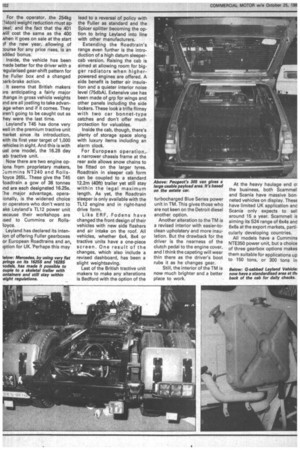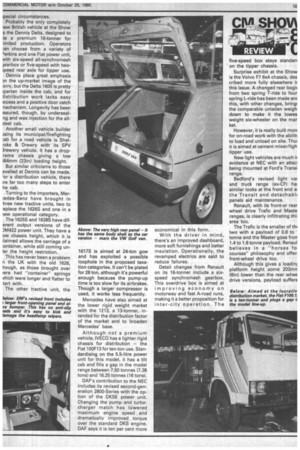What's in it for us?
Page 103

Page 104

Page 105

If you've noticed an error in this article please click here to report it so we can fix it.
The Show has seen many changes, but don't be blinded by science. Steve Gray takes a cool look at the plusses (and the minuses) for operator and driver.
kLTHOUGH at first sight there ion't seem to be many corn)letely new models at this year's Thaw, there have been changes o existing vehicles so let's take I look at them from the )perator's and driver's rtandpoint.
As Graham Montgomerie has Jescribed elsewhere in this iswe, one of the main characterisics of the Show has been menu:acturers attempts to reduce JnIaden weight to improve )ayload capability.
These days, this could mean he difference between staying n business or not.
ERF has chipped up to 508kg 1/2 ton) off the unladen weight of Is B-Series tractive units, de)ending on engine specification.
Many of the weight losses lave already been achieved by itting alloy bumpers, alloy fuel :anks, a lighter frame and a dif:erent rear axle. Obviously, EBF's engineers have done their lomework with regard to the .:hassis stress requirements and he longevity of minimum leaf ;p rings.
But I have doubts about an alloy bumper, which must cost 3 n arm and a leg to replace if it's lamaged. As regards the alloy 'uel tank, one glancing blow 'ram a forklift truck and there's mother costly repair job.
Alloy wheels may look very lice, but they're a prime target or thieves and again must cost a 'ortune to replace. If the operator is happy to accept these risks, then the payload advantage offered will eventually recoup the higher first cost.
Because of the simple moulds needed to manufacture grp panels, ERF is able to alter them without too much effort. For its show models it is exhibiting the latest variant of the B-Series cab, the SP3. A wider lift-up front panel allows access to all those components at the vehicle front and also permits the use of ERF's electrical diagnostic tester.
My only complaints concern the size of the panel -1 it's pretty big and it doesn't look that robust and the glass-covered headlamps which have -wipers on the covers. These latter look as if they could be easily damaged by a driver's foot when he climbs up to clean the screen. Incidentally, there are no antislip pads on the alloy bumper, so care is necessary here.
Another British manufacturer showing weight loss is Seddon Atkinson with its 401. Appealing to the driver, the big A returns to the grille which is now of grp. Different chassis cross-members and an alloy tank are other weight losers, along with lighter springs and a redesigned front bumper using smc {sheet moulding compound) with a steel backing.
Earlier comments about the alloy components obviously apply here, though I'm not sure how the composite bumper will stand up to service life. No doubt time will tell. For the operator, the 254kg :1/4ton) weight reduction must appeal; and the fact that the 401 Nil cost the same as the 400 Nhen it goes on sale at the start pf the new year, allowing of :.ourse for any price rises, is an ]dded bonus.
Inside, the vehicle has been riade better for the driver with a .egularised gear-shift pattern for :he Fuller box and a changed park-brake action.
It seems that British makers )re anticipating a fairly major hange in gross vehicle weights )nd are all jostling to take advanage when and if it comes. They iren't going to be caught out as hey were the last time.
Leyland's T45 has done very vell in the premium tractive unit rarket since its introduction, Nith its first year target of 1,000 tehicles in sight. And this is with ust one model, the 16.28 day :ab tractive unit.
Now there are two engine opions from proprietary makers, :ummins NT240 and Rollsloyce 265L. These give the T45 loadtrain a gcw of 38 tonnes Ind are each designated 16.25s. The major advantage, opera ionally, is the widened choice or operators who don't want to
ake Leyland's TL12 power unit )ecause their workshops are lsed to Cummins or Rolls
loyce.
Leyland has declared its inten ion of offering Fuller gearboxes or European Roadtrains and an, )ption for UK. 'Perhaps this may lead to a reversal of policy with the Fuller as standard and the Spicer splitter becoming the option to bring Leyland into line with other manufacturers.
Extending the Roadtrain's range even further is the introduction of a high datum sleepercab version. Raising the cab is aimed at allowing room for bigger radiators when higherpowered engines are offered. A side benefit is better air insulation and a quieter interior noise level (75dbA). Extensive use has been made of grp for wings and other panels including the side lockers. These look a trifle flimsy with two car bonnet-type catches and don't offer much protection for valuables.
Inside the cab, though, there's plenty of storage space along with luxury items including an alarm clock.
For European operation,. a narrower chassis frame at the rear axle allows snow chains to be fitted on the larger tyres. Roadtrain in sleeper cab form can be coupled to a standard 12.2m (40ft) trailer yet still stay within the legal maximum length. As yet, the Roadtrain sleeper is only available with the TL12 engine and in right-hand drive form.
Like ERF, Fodens have changed the front design of their vehicles with new side flashers and air intake on the roof. All vehicles, whether 6x4, 8x4 or tractive units have a one-piece screen. One result of the changes, which also include a revised dashboard, has been a slight weightsaving.
Last of the British tractive unit makers to make any alterations is Bedford with the option of the turbocharged Blue Series power unit in TM. This gives those who are not keen on the Detroit diesel another option.
Another alteration to the TM is a revised interior with easier-toclean upholstery and more insulation. But the drawback for the driver is the nearness of the clutch pedal to the engine cover, and I think the capeting will wear thin there as the driver's boot rubs it as he changes gear.
Still, the interior of the TM is now much brighter and a better place to work. At the heavy haulage end o the business, both Scammel and Scania have massive bon neted vehicles on display. These have limited UK application and Scania only expects to sell around 15 a year. Scammell is aiming its S24 range of 6x4s and 6x6s at the export markets, particularly developing countries.
All models have a Cummins NTE350 power unit, but a choice of three gearbox options makes them suitable for applications up to 150 tons, or 300 tons in ;pedal circumstances.
Probably the only completely lew British vehicle at the Show s the Dennis Delta, designed to )e a premium 16-tonner for imited production. Operators an choose from a variety of 'erkins and one Fiat power unit, rvith six-speed all-synchromesh 3earbox or five-speed with two;peed rear axle for tipper use.
Dennis place great emphasis )n the up-market image of the orry, but the Delta 1600 is pretty ;partan inside the cab, and for iistribution work lacks easy ;ccess and a positive door catch nechanism. Longevity has been 3ssured, though, by undersealng and wax injection for the all;teel cab.
Another small vehicle builder 'sing its municipal/firefighting :ab for a road vehicle is Shelroke & Drewry with its SPV 3rewery vehicle. It has a droprame chassis giving a low i84mm (23in) loading height.
But similar criticisms to those evened at Dennis can be made. 'or a distribution vehicle, there ire far too many steps to enter he cab.
Turning to the importers, Mer:edes-Benz have brought in hree new tractive units, two to eplace the 16265 and one in a lew operational category.
The 1625S and 1628S have diferent output versions of the )M422 power unit. They have a ow chassis height, which it is ilaimed allows the carriage of a :ontainer, while still coming unler the height restriction.
This has never been a problem n the UK with the old 1626, hough, as those brought over iere had "container" springs vhich were longer and flatter to tart with.
The other tractive unit, the 1617S is aimed at 24-ton gcw and has exploited a possible loophole in the proposed taxation categories. It can't be plated for 28 ton, although it's powerful enough because the pump-up time is too slow for its airbrakes. Though a larger compressor is used, it works less frequently.
Mercedes have also aimed at the lower rigid weight market with the 1213, a 13-tonner, intended for the distribution factor of the market and to broaden Mercedes' base.
Although not a premium vehicle, IVECO has a lighter rigid chassis for distribution — the Fiat 100F13 for ten-ton use. Standardising on the 5.5-litre power unit for this model, it has a tilt cab and fills a gap in the model range between 7.50 tonnes (7.38 tons) and 16.25 tonnes (16 tons).
DAF's contribution to the NEC includes its revised second-generation 2800-Series with the option of the DKSE power unit. Changing the pump and turbocharger match has lowered maximum engine speed and dramatically improved torque over the standard DKS engine. DAF says it is ten per cent more economical in this form.
With the driver in mind, there's an improved dashboard, more soft furnishings and better insulation. Operationally, the revamped electrics are said to reduce failures.
Detail changes from Renault on its 16-tonner include a sixspeed synchromesh gearbox. This overdrive box is aimed at improving economy on motorway and fast A-road runs, making it a better proposition for inter-city operation. The five-speed box stays standar( on the tipper chassis.
Surprise exhibit at the Show is the Volvo F7 6x4 chassis, des cribed more fully elsewhere ir this issue. A changed rear bogi( from two spring T-ride to four spring L-ride has been made an( this, with other changes, bring: the comparable unladen weigh down to make it the lowes weight six-wheeler on the mar ket.
However, it is really built mon for on-road work with the abilit) to load and unload on site. Thu: it is aimed at cement mixer/ligh tipper use.
New light vehicles are much ir evidence at NEC with an attacl being mounted at Ford's Transi range.
Bedford's revised light var and truck range (ex-CF} ha: similar looks at the front end a: the Transit and detachabli panels aid maintenance.
Renault, with its front-or rear wheel drive Trafic and Maste ranges, is clearly infiltrating thi: area too.
The Trafic is the smaller of thi two with a payload of 0.8 to • tonne and the Master goes frorr 1.4 to 1.8 tonne payload. Renaul believes in a "horses fo courses" philosophy and offer front-wheel drive too.
Although this gives a loadim platform height some 203mrr (Bin) lower than the rear whee drive versions, payload suffers
























































































































































